
Over the past 15 years, the aerospace sector in Peterborough and the Kawarthas has climbed to new heights and is continuing to soar.
With the Peterborough Airport at its centre, the region has become a leader in aerospace innovation with an ideal location, cutting-edge training and research programs, the presence of international and expanding businesses, and specialized services.
“The Peterborough Airport has experienced tremendous growth, solidifying its position as a hub for aerospace innovation and employment in Ontario,” says Kyle Bruce, Manager of Airport Administration. “The airport’s success has attracted a diverse range of businesses and training facilities, making it a key driver in the region’s economic development.”

That success is the continued result of the Peterborough Airport Master Plan, which was created in 2009 and updated in 2022 to guide the positioning of the airport as an economic leader in meeting future aviation demand and creating local employment.
Since launching the airport development program in 2010, the Peterborough Airport has seen full-time jobs double from 251 to more than 500, with 22 businesses currently residing on site and more to come. The sector’s regional GDP has more than doubled, from $40 million to $90 million.
Bruce points to the airport’s strategic location as a gateway to the eastern GTA as a contributor to encouraging growing aviation businesses to make a home in the airport.
“The supportive business environment is another key factor, with local governments offering incentives and streamlined processes to foster growth,” he says, adding the region has even more to offer. “The region’s quality of life, including natural beauty and affordable living, makes it attractive to both businesses and employees. All these factors create a dynamic, thriving ecosystem for aerospace companies.”
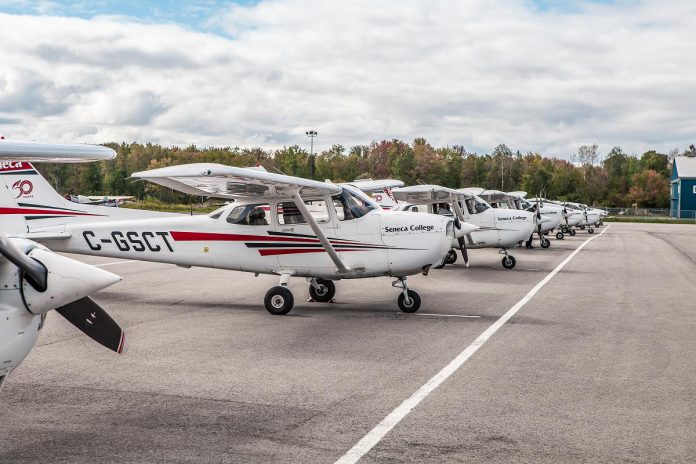
For workers, a wide range of employment opportunities are available at the Peterborough Airport, especially in maintenance, repair, and overhaul (MRO) businesses. Whether they are new graduates entering the sector for the first time or seasoned professionals looking for a change, employees always have opportunities to ascend the career ladder of their chosen profession.
“The close collaboration between companies, training facilities, and educational institutions enables continuous skill development, helping employees advance within their organizations,” says Bruce. “The airport’s focus on growth also means businesses are expanding, creating new roles and leadership opportunities, and allowing employees to build long-term careers within the region.”
To meet the growing demand for skilled employees, the Peterborough Airport offers top-notch training facilities for educational institutions. In 2014, Seneca Polytechnic relocated its four-year Bachelor of Aviation Technology program — the only program of its kind in Canada — to the Peterborough campus at the airport. Combining in-class learning and on-the-job placements, the program sets students up for success in careers in aviation and aerospace.
“When it comes to future growth and development, nothing would be possible without skilled labour,” says Bruce.
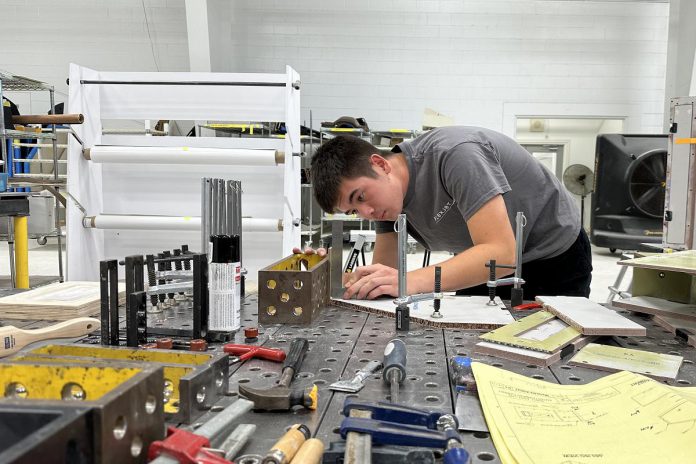
With the Specialist High Skills Major (SHSM) program led by the Peterborough Northumberland Victoria and Clarington Catholic School Board, even teenagers can explore future career opportunities available at the Peterborough Airport.
This past summer, students in the SHSM program were given the opportunity to work an eight-week summer placement with aviation and aerospace businesses at the airport through the Build & Soar program delivered by Peterborough & the Kawarthas Economic Development (PKED) and its partners. Participating businesses were given a 50 per cent wage subsidy, while students received on-the-job training and paid workplace opportunities, many of which have led to part-time employment beyond the summer.
“There is a place for all skills to be valued in the supply chain surrounding the airport’s interconnected community of businesses, and that starts with teaching a new generation of learners where they can fit in and flourish,” says Bruce. “By ensuring we give as many local students as possible the chance to get their start in aviation, we can ensure that the future demands for careers in aviation are met.”
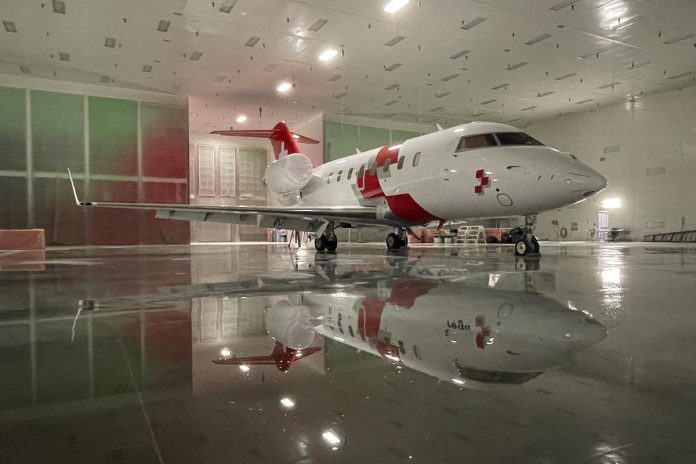
As for future growth of the Peterborough Airport, Bruce says the airport will build upon the momentum by focusing on emerging trends and being a leader in innovative research. For example, Fleming College is involved in cutting-edge research on an electric vertical take-off and landing (eVTOL) aircraft — a more sustainable aircraft that could be the future of aviation.
“The airport’s focus on emerging trends, like sustainable aviation and workforce development, positions it as a hub for MRO, testing, and innovation,” says Bruce. “This proactive approach, combined with its strong infrastructure and expanding industry connections, will help attract new businesses and sustain economic growth in the region.”
That includes outreach efforts such as attending aerospace industry trade shows like the Farnborough International Airshow in the United Kingdom. Representatives from the Peterborough Airport and PKED travelled to Farnborough this past July, where they met with aerospace manufacturers, unmanned aerial vehicle (UAV) service providers, and eVTOL developers, and came away with leads for potential airport tenants. The momentum gained at Farnborough continued with the Airport’s Business Enablement Team booth at October’s DAIR to Innovate show at Centennial College.
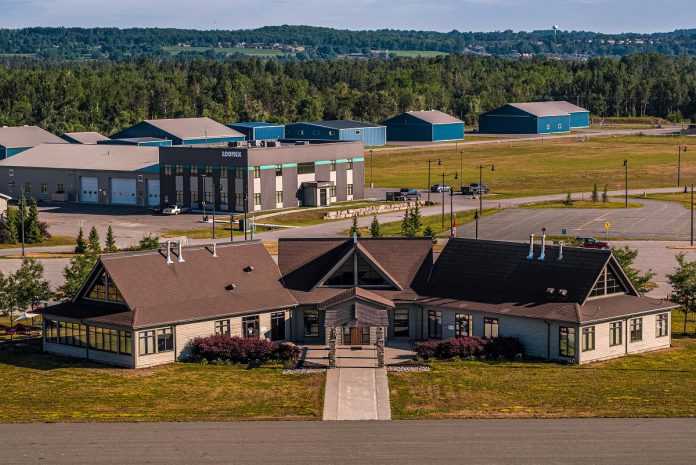
“Peterborough Airport is committed to maintaining its growth by leveraging its strategic advantages, including its proximity to Toronto and Ottawa, and access to skilled talent from nearby colleges and universities,” Bruce notes. “Attending key industry events, like the Farnborough International Airshow and DAIR to Innovate, plays a crucial role in this strategy.”
Aside from the leads generated at Farnborough, three companies are planning investments at the Peterborough Airport over the next year, including a flight training unit, the development of a commercial aircraft hangar, and the potential development of energy infrastructure.
“The expansion of Peterborough Airport has not only transformed the region’s aerospace industry but has also reaffirmed the area’s status as an ideal place to pursue a long-term, successful career in aviation and aerospace,” says Bruce.
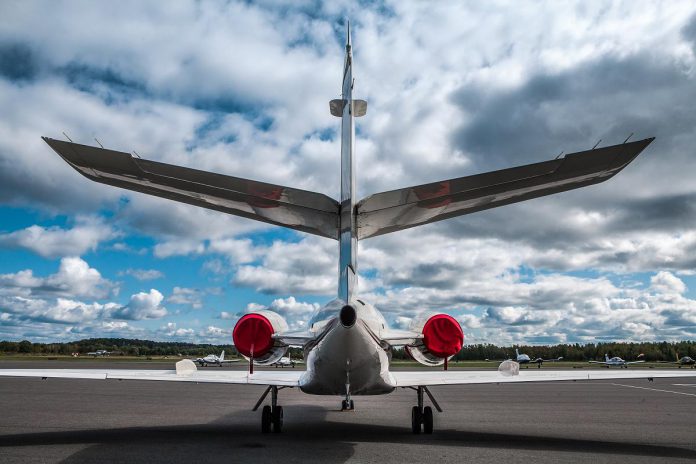
Bruce adds that the airport’s continued growth is a key driver for the region’s overall economic success.
“The growth has a ripple effect on the broader regional economy, driving development in multiple industries,” Bruce points out. “As aerospace businesses expand, they create demand for local supplies, construction companies, logistics services, and professional supports. Additionally, job creation within the aerospace sector boosts consumer spending, which benefits retail, hospitality, and housing markets.”
Explore training and employment opportunities at the Peterborough Airport at peterborough.ca/en/doing-business/airport-services.aspx.
This branded editorial is one of a series created in partnership with Peterborough & the Kawarthas Economic Development. If your organization or business is interested in a branded editorial, contact us.


























